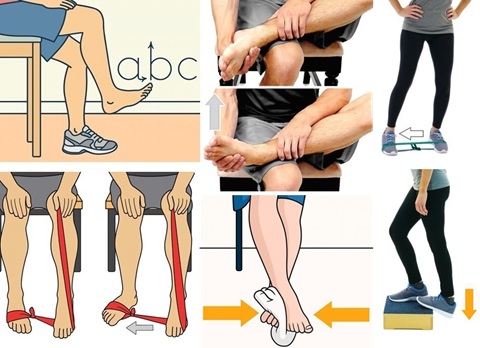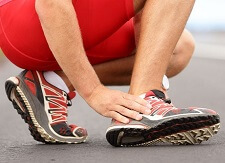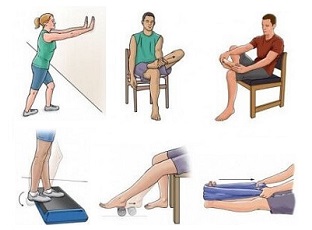- Home
- Common Foot Problems
- Tendonitis Guide
- Peroneal Tendonitis
Peroneal Tendonitis
Written By: Chloe Wilson BSc(Hons) Physiotherapy
Reviewed By: FPE Medical Review Board
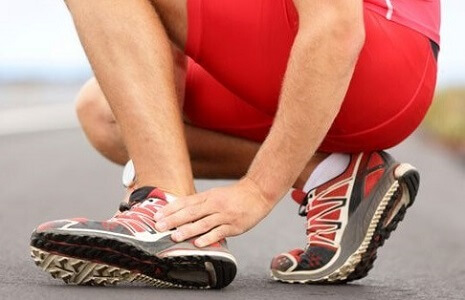
Peroneal tendonitis is a common cause of foot pain, particularly around the ankle.
Frequently affecting runners or athletes who have upped their training, peroneal tendonitis usually develops slowly, gradually getting worse and worse.
Repetitive overloading or stretching of the peroneal tendons can cause small tears in the tendons which leads to inflammation, irritation, weakening and degeneration. The result is pain on the outer ankle which gets worse with activity.
What Is Peroneal Tendonitis?
Peroneal tendonitis is when there is inflammation and degeneration of the peroneal tendons on the outer side of the foot.
Tendons are strong, cord-like structures that link muscles to bones. In order to move, our muscles contract, which pulls on the appropriate tendon which in turn pulls on the appropriate bone.
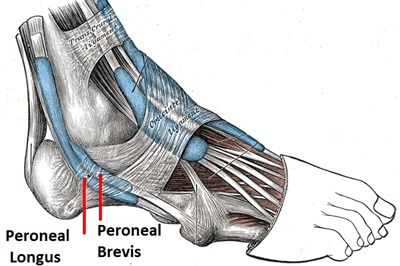
There are two peroneal muscles, peroneal longus and peroneal brevis.
They work to pull the foot and toes downwards, known as “plantarflexion” and to turn the foot outwards, known as “eversion”.
The peroneal tendons run down the back of the fibula (outer shin bone) through a groove on the outer side of the ankle behind the lateral malleolus.
- Peroneus Brevis attaches to the base of the little toe
- Peroneus Longus tendon crosses under the sole of the foot attaching to the big toe
Foot Tendonitis occurs when the tendons are over-used or placed under too much tension, usually from repetitive movements causing a strain on the tendon.
Micro-trauma from overuse or repetitive tension on the peroneal tendons, or an ankle injury such as a sprain, damages the tendons which can lead to peroneal tendonitis.
What Causes Peroneal Tendinitis?
There are a number of different causes of peroneal tendinopathy:
- Overuse: Overuse is the most common cause of peroneal tendonitis. Sudden increases in
training levels, inappropriate footwear or poor training techniques
tend to be to blame. Sports such as basketball, football and gymnastics, or anything requiring quick pivoting movements are also commonly associated with the peroneal tendonitis tears
- Running: Runners who frequently run along slopes e.g.
cambered roads or uneven surfaces, which cause the foot to excessively
roll out into eversion, are more prone to peroneal tendinitis
- Injury: You may also be prone to peroneal tendon problems if you have injured your ankle or suffered from recurrent ankle sprains. Repeatedly damaging the ligaments that support the foot and ankle leads to weakness and instability which can put more strain on the peroneal tendons
- Abnormal Foot Position: Typically if the heel is turned inwards slightly, known as “hindfoot varus”, or you have high arches, you are at increased risk of peroneal tendonitis as these makes the peroneal muscles and therefore tendons work harder
- Muscle Imbalance: Tightness in the calf muscles and weakness in the calf and peroneal muscles can lead to tendonitis. Visit the Calf Exercises section to find out the best ways to strengthen and stretch the calf muscles
Symptoms Of Peroneal Tendinopathy
The common symptoms of peroneal tendonitis usually include:
- Foot & Ankle Pain: People suffering from peroneal tendonitis tend to complain
of pain and tenderness around the back and outside of their foot and ankle
- Gradual Onset: The pain from peroneal tendinopathy tends to come on gradually over a few
weeks or months
- Worse With Activity: peroneal tendonitis pain usually gets worse with activity and eases with rest.
- Worse In The Morning: Peroneal tendonitis tear symptoms often tend to be worse first thing
in the morning, easing once you are up and about
- Pain With Inversion: It may also hurt to turn your foot inwards, known as inversion, as this movement stretches the tendons.
#CommissionEarned from Amazon on qualifying purchases
Peroneal Tendonitis Treatment
Peroneal tendonitis treatment usually involves a combination of:
- Rest: It is essential to avoid any activity which aggravates your peroneal pain symptoms, to allow the tendon to heal properly. Failure to do so will result in longer healing time. In severe cases, your doctor may recommend crutches or a walking boot to help take the tension off the tendon
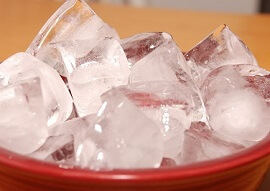
- Ice: Applying ice regularly to the outer ankle can help to reduce pain and inflammation from peroneal tendinopathy. Either use a regular ice pack or you can get specially designed ankle ice wraps that strap around the ankle so they stay in place as you move around.
- Compression: Wearing a tubigrip compression bandage or a support brace can help to reduce the inflammation and instability associated with peroneal tendonitis
- Elevation: When resting, keep the ankle elevated higher than the heart using a leg cushion
- NSAIDS: Talk to your doctor about taking non-steroidal anti-inflammatories such as ibuprofen to reduce the pain and swelling
- Creams/Gels: People with tendonitis often find rubbing creams such as Tiger Balm or Arnica into their foot really helps to reduce peroneal tendonitis pain
- Change Training Structure: Don’t overdo it especially when trying to increase your activity levels if you have peroneal tendonitis. Follow the 10% rule - only increase your training levels by a maximum of 10% per week be it intensity, frequency or distance. If you are a runner, stick to flat, smooth surfaces to help avoid peroneal pain
- Exercises: Regularly doing strengthening and stretching exercises for peroneal tendonitis will help reduce the tension on the peroneal tendons. This helps to speed up healing and reduces the chances of peroneal pain recurring
- Orthotics: If your tendonitis is due to abnormal foot shape, it often helps to wear inserts in your shoes to correct the deformity. Ideally, you should see a podiatrist who can evaluate your foot and ensure you have the right insoles for you. Using the wrong insoles may end up causing you more problems
- Acupuncture: Acupuncture can
sometimes help to reduce pain associated with peroneal tendinitis but needs to be
combined with other treatments such as exercises to stop the pain from coming back
- Physical Therapy: Physical therapy is an important part of peroneal tendonitis treatment and may include joint mobilisations if there is stiffness in the bones of the foot, taping to improve foot position and ultrasound to reduce inflammation and promote healing
It is important to incorporate a range of these peroneal tendonitis treatment options, not just to speed up healing, but to help reduce the risk of the problem returning.
Differential Diagnosis
Peroneal tendonitis is just one possible cause of pain on the outside of the foot. There are a number of other conditions that can cause similar symptoms such as:
- Ligament Sprain: overstretching or tearing of one of the ankle ligaments
- Cuboid Syndrome: common cause of persistent outer ankle pain
- Posterior Tibial Tendonitis: causes pain at the inner ankle
- Tibialis Anterior Tendonitis: causes pain at the front of the ankle
- Shin Splints: causes pain and tenderness along the shin bone
If peroneal tendonitis isn't sounding quite like your problem, visit the Side Foot Pain section. Alternatively, if you want help working out what is causing your pain, visit the foot pain diagnosis section.
Tendonitis can also occur in a number of places around the ankle and foot. Visit the foot tendonitis section to learn about the different types of tendonitis and how to treat them.
Peroneal Tendonitis Recovery Time
Peroneal tendonitis recover time can vary from a few weeks to a few months depending on what you do so effective treatment and regularly doing peroneal tendonitis exercises is vital.
In order to speed up peroneal tendonitis recovery time, it is really important to avoid any activities that aggravate your peroneal pain so the tendon has a chance to heal without being repeatedly irritated. Failure to do so will delay healing and slow down the recovery time.
Once the pain subsides, you can start returning to your usual activities but make sure to take it slowly and follow the 10% rule to reduce your chances of peroneal tendonitis coming back.
It is really important to stick with your peroneal tendonitis treatment plan until your symptoms have fully settled otherwise there is a high chance that the symptoms will return.
Peroneal Tendonitis Summary
Peroneal tendonitis is a common cause of pain on the outside of the foot.
It frequently affects athletes and runners, particularly if you have suddenly increased your activity levels.
Peroneal tendonitis is caused by inflammation and degeneration of one of the outer foot tendons, usually caused by overuse, training errors, foot injuries, muscle imbalance or altered foot biomechanics.
Treatment for peroneal tendonitis usually involves a combination of rest, ice, medications, changing training plans, peroneal tendonitis exercises and orthotics.
It can take anything from a few weeks to a few months to recover fully from peroneal tendonitis.
You may also be interested in the following articles:
- Pain On Top Of Foot
- Foot Arch Pain
- Inner Foot Pain
- Nerve Pain In The Foot
- Foot & Ankle Stretches
- Swollen Foot Treatment
- Foot Numbness
- Foot Lumps & Bumps
Related Articles
Page Last Updated: 12th November, 2025
Next Review Due: 12th November, 2027
